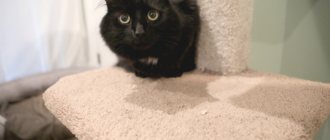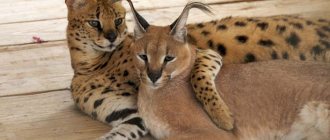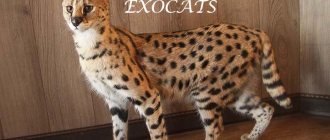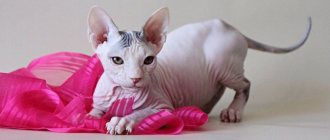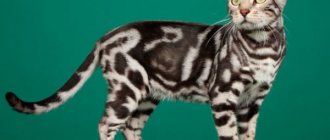08/31/2018 Category: Pets Author: Anna Darinova
Recently, the fashion for everything exotic and unusual has been gaining momentum. This trend has not spared pets either. You can increasingly see foxes and raccoons walking on a leash on the street, lynxes and even bears in the enclosures of country houses. However, there is a much safer option for an exotic pet - the serval.
- 2 Appearance of a serval
2.1 Serval subspecies2.1.1 Photo gallery: subspecies of serval
- 5.1 Photo gallery: vitamins for the serval
- 6.1 Photo gallery: shampoos for serval
- 9.1 Table: advantages and disadvantages of the serval
History of the Serval breed
The serval (bush cat) is a wild species of the cat family. Its homeland is Africa. Interest in cats flared up several hundred years ago, but at that time people were interested in the handsome servals only as a source of valuable fur and meat. They also hunted servals for fun. As a result, the population of the once most common cats in Africa has decreased by approximately three times. But despite such frightening numbers, today only one subspecies of serval is included in the Red Book. All other cats are protected. The largest population lives in Tanzania, in the Ngoro Ngoro National Park.
The Serval is a wild African cat that has been tamed.
The ancient Egyptians showed interest in servals as domestic cats. Babies were taken from the wild and tamed. Servals became a real salvation for the Egyptians from mice and other rodents, for which cats were considered sacred.
At the end of the 19th century, Europeans drew attention to long-legged African cats. They also discovered that serval kittens are perfectly tamed and become affectionate pets. At the same time, attempts were made to hybridize servals, which were successful only in the middle of the twentieth century, giving the world Savannah cats.
The serval's natural habitat is the African savannah.
Servals remain one of the most expensive and elite breeds to this day. They are not recognized by any felinological organization, since, strictly speaking, they are not a breed, but a species of cat. The export of wild cats from Africa is prohibited, so there are very few breeding Servals around the world.
Appearance of a serval
Serval does not have an established standard, but organizations are actively working to develop one. The general appearance of the serval is somewhat reminiscent of a cheetah, although a distant relationship between servals and lynx has been established. Appearance of a bush cat:
- Dimensions:
- height - from 40 to 60 cm;
- body length - from 100 to 130 cm;
- the tail length is small - from 25 to 40 cm;
- leg length - approximately 2/3 of height;
- weight - from 10 to 18 kg.
Servals are big cats - Head:
- huge, high and close-set ears with rounded tips, abundant brushes and black tassels, which indicate some genetic relationship with lynxes;
- the size of the head is small in relation to the body;
- the bridge of the nose is thick, the nose itself is quite wide, painted black;
- the eyes are small, almond-shaped. The upper line of the eye has the shape of a boomerang;
- head shape is wedge-shaped;
- cheekbones are high and pronounced;
- when viewed from the front, the head takes on an ellipsoidal shape;
- vibrissae pads small, light;
- the chin is not protruding, in harmony with the overall shape of the head and muzzle;
- the fangs are quite impressive, can reach 2–3 cm in length;
- the mouth is large and wide;
- the line of the forehead is slightly rounded and quite long, it goes into the nose almost without a break;
- the stop (curve) of the nose is insignificant, ideally the lines of the forehead and nose almost merge;
- Black stripes descend from the inner corners of the eyes to the nose, which in nature are needed to reflect light.
The serval's peculiarity is its huge ears, thanks to which the cat can hear the prey while being 1 km away from it. - The neck is long and thin, gracefully arched.
- Body:
- the torso is quite long and thin, with noticeable muscles;
- There may be a small amount of loose skin between the hind legs;
- thighs slightly thicker than shoulders;
- the line of the back should be flat or with a slight deflection, the shoulder blades should be clearly visible;
- the skeleton is quite thin, the cat is flexible and mobile;
- the belly line is flat or with a slight deflection to the ground;
- the chest is flat and thin;
- The front legs are distinguished by thin bones, absolutely smooth, and the hind legs are more massive, more muscular and longer. The serval has this structure of legs in order to jump high and grab prey. This is also due to the short tail length;
- the cat's fingers are elongated and quite flexible, which helps her grab prey;
- the feet are round and small.
Black servals are found, but extremely rare. - Coat and color:
- The predominant color is sandy and golden coat with a light yellow belly and the inside of the legs. Depending on the subspecies, the shade may vary;
- the pattern is spotted with thick short stripes on the upper back, shoulder blades and legs. The pattern also extends to the abdomen;
- on the tail there are ring stripes, the tip of the tail is black;
- on the cat’s forehead you can discern a pattern in the form of the letter “M”;
- the spots on the chest are small, arranged in even rows;
- The color of the pattern is dark brown or black, the spots must be clear and prominent. The size and clarity of the spot depends on the subspecies;
- the coat itself is quite short, slightly tousled, and not without undercoat;
- eye color can be gray, brown, yellow and greenish;
- In the wild, there are melanistic servals, that is, black in color. There are few of them, and almost all of them live in the mountainous regions of Kenya;
- Albinos also appeared among the servals, but they were all born only in captivity. For all the time that man has known about servals, only 5 albino servals have been recorded.
An albino serval named Toga is one of only five white servals ever born.
Serval subspecies
There are a total of 19 subspecies of serval in the wild. They practically do not differ in appearance (the difference is only in the shade of the coat and the contrast of the pattern). Their main difference is their habitat.
Serval subspecies:
- Bair serval. Opened in 1910. It lives on the Atlantic coast of Mozambique and near Lake Jozini.
- Sahelian serval, servalin. Opened in 1841. It is distinguished by clear black spots, longitudinal stripes on the neck and a dark golden color. Range - from Ethiopia to Sierra Leone. The peculiarity of servalin is that a mutation of the pattern may appear when there are almost no spots on the cat’s body.
- North African serval. Discovered in 1780 The same subspecies listed in the Red Book. The area is the central part of Morocco. This serval primarily hunts in or near water for amphibians and birds. Along its back there is a stripe of fused spots.
- Farajian serval. Discovered in 1924. Distinguished by small, frequent spots on the skin. Habitat: northeast of Congo (country).
- Leptailurus serval ferrarii. Discovered in 1924. The main range is southern Somalia. It is quite rare.
- Hamilton's serval. Discovered in 1931. Habitat: South Africa, Kruger National Park and the Satara region.
- Tanzanian serval. Opened in 1910. It is distinguished by a horseshoe-shaped stripe on the shoulder blade and a light sandy color. Habitat: Tanzania, northern Mozambique, southern Kenya.
- Kemp's Serval. Lives in the vicinity of Mount Elgon. There are several subspecies of the Kempian Serval:
- Leptailurus serval kempi. This cat is slightly smaller than its relatives, with small spots of pattern and light color. Opened in 1910;
- Leptailurus serval lipostictus. A large serval, also with small spots and a dark stripe on the back. The coat color is golden, the spots are not distinct;
- Leptailurus serval pantastictus. A large cat with clear spots and a light sandy color. There are three longitudinal stripes on the back. Opened in 1910;
- Senegalese serval (L. s. pococki). A cat with a not very clear pattern, light sandy fur. Habitat: border of Senegal and Gambia.
- Serval Kivu. Opened in 1919. Habitat: Congo and Angola.
- South Angolan Serval. Discovered in 1910, distributed in southwestern Angola.
- Botswana serval. Opened in 1932. Distributed in northwestern Botswana.
- Phillips Serval. Opened in 1914. Habitat: the entire Horn of South Africa.
- Roberts Serval. Discovered in 1953, it has the longest legs among servals. The wool is dark golden with a clear pattern. Distributed in South Africa.
- Cape Serval. It was one of the first to be opened, in 1776. The most common of all subspecies. It has light fur and an almost black, perfectly clear pattern. Habitat: from Congo to the Cape Province in South Africa.
- Togolese serval. Lives in Nigeria, Tongo and Benin. Opened in 1893.
Photo gallery: subspecies of servals
Servals in Kempa, like other subspecies, were brutally hunted
Kivu servals live in Congo and Angola
Roberts servals are very rare
The North African serval can survive even in desert conditions
The main prey of the Hamilton serval is rodents and reptiles
The Sahelian Serval may have almost no spots on its skin.
The Togolese Serval jumps very high thanks to its strong hind legs.
Leptailurus serval ferrarii may be included in the Red Book as an endangered subspecies of serval
The first Serval Phillips was discovered in 1914
The Southern Angolan serval got its name due to its habitat - southern and western Angola
Little is known about the Beira Serval
The Botswana Serval lives in northern Botswana
The Cape Serval is the most common of all subspecies
On the shoulder of the Tanzanian Serval the stripes form a horseshoe shape.
If you save a little...
There are other breeds of cats that surprise with their stern appearance, but at the same time are completely domestic purrs. For example, chausie, which, perhaps, can be classified in the middle price category. This is a cross between an Abyssinian cat and a swamp lynx; in Moscow, kittens cost from 30 thousand rubles, but the price can reach 200 thousand (depending on the title of the parents and the proportion of wild blood).
Another wild one for the middle class is the pixie bob, the result of crossing domestic cats with wild short-tailed forest cats. Docile and unpretentious animals have a number of features of their forest ancestors - the look of a wild animal, tassels and sideburns, like a lynx.
Health and illness
The Serval is a wild cat, so it has no genetic health problems. However, they do not tolerate cold easily, as they are adapted to the hot African climate. The serval can also be affected by infections and feline diseases that are not typical for African cats: colds, feline leukemia (FeLV), panleukopenia, herpesvirus. Therefore, it is very important to vaccinate your kitten on time - this will help avoid health problems.
Otherwise, servals are very hardy and healthy: they do not suffer from heart disease, stomach disorders, urolithiasis or obesity. In captivity, the serval lives up to 20 years.
Servals have good health, but are susceptible to infectious diseases
Character, behavioral features of the serval
The serval is first and foremost a wild animal whose instincts can manifest themselves at any moment. Fortunately, this savagery is not directed at humans, since in the wild they are not prey for the serval. But from the sharp claws of a serval and its impressive teeth, it is quite possible to get serious injury.
That is why it is recommended to adopt a serval as early as possible. Typically, a serval is given to a family at 1.5–2 months. Only with early socialization will the serval become an affectionate pet.
To raise a tame serval, it must be taken into the home no later than 5 months
A tamed serval spends its irrepressible energy running and playing. Therefore, it is impossible to keep servals in a small city apartment without constant walking. A cat needs as much space as possible, places to climb, jump and play. The jump height of a serval can reach 4 meters, so a wild cat will literally walk on the ceiling without proper physical exertion. Ideally, the Serval should be kept in a spacious country house with access to the garden.
Servals (both males and females) mark noticeably, and the smell of these marks is much more unpleasant than the smell of domestic cats. Therefore, servals are neutered at 7–10 months.
Servals are friendly towards large pets.
The Serval needs to be given time to get used to its new environment and family members. If the owner does everything right and provides the pet with proper care, the serval will become an unusually affectionate and devoted cat. All owners note that Servals’ attachment to humans borders on that of a dog. As do intelligence and learning ability: servals quickly learn to interact with their owner and carry out even the most complex commands. The main thing is to find the right approach to it.
Thanks to his high intelligence, it is easy for a serval to explain what is possible and what is not allowed in his new home. But under no circumstances shout or hit the serval! This way you will lose his respect and trust. For example, if a cat climbs tables, it is enough to arm yourself with a water pistol. Having caught your pet on the table, clearly command “No!” and sprinkle water into it. The serval will very quickly understand what he is doing wrong.
Servals are highly trainable
When not running around the house, bush cats are the epitome of equanimity and calm. Servals are compliant and sociable, ready to watch a person all day long. But strangers are treated with suspicion and try to hide. The same thing happens if the serval never learned to trust its owner. In this case, the animal becomes dangerous.
No matter how many cat complexes and trees there are in your house, the serval will still explore all the tall objects in the house. Therefore, where the serval lives, there is no place for small, fragile things, paintings on the walls and flower pots. The serval loves to chew everything that gets into its mouth, so you need to hide all wires and other soft things in advance. If the cat has become accustomed to chewing what it is not supposed to, apple spray, sold in pet stores, will help rid him of this habit.
Servals love to walk in nature
The play set for a serval should be large enough and durable. It is necessary to add strong ropes to its design - servals love to grab them with their teeth and hang. Buy toys that are large and strong so that the cat does not chew or swallow them.
You need to play with a serval every day and for a long time, especially with a kitten. In this case, play is combined with education: a serval should under no circumstances bite or scratch. If a kitten begins to behave like a wild animal during play, you should immediately stop playing and leave the room. This way the pet will learn how to behave correctly with a person.
It is better to hide all small and easily breakable things from the serval.
The serval's voice is quite loud, somewhat reminiscent of the chirping of a bird. The cat uses it infrequently, mainly when he is unhappy, happy or hungry.
Small children should not be left with the Serval. A wild cat will not tolerate it if an intrusive child pulls its tail, ears, or paws. The serval will definitely use its claws and teeth, and will become terribly afraid of small children, as it will feel threatened by them. Therefore, it is better not to take a serval into a home with children under 7–10 years old. If a child treats the pet correctly, the serval will be a devoted and affectionate friend.
In order for a serval to give vent to its irrepressible energy, they need to play at least 2-3 hours a day
The Serval gets along with pets only if they are not much smaller than themselves and are friendly. The serval can mistake small cats and dogs, rodents and birds for prey.
Character, intelligence and habits
Domestic servals raised in nurseries are surprisingly friendly and affectionate animals that pose virtually no danger to humans. However, they are categorically not recommended for families with small children who have not yet learned to respect animals.
In general, servals are sociable, playful and intelligent. They are very kind and gentle towards all family members. They prefer to sleep in bed and are rarely aggressive towards strangers. Only if they have not previously had experience communicating with other people can they avoid contact. One could even say that the serval’s character contains a certain timidity and cowardice. It is important for these cats to feel protected and to know that there is a safe place nearby.
By nature, servals are very curious; they enjoy learning new games and exploring previously unfamiliar territories. As a rule, they get along well with other cats. Cohabitation with a dog depends on the latter’s character. The serval will not mind making friends and playing together if they do not show aggression towards him. Rodents, birds, and ferrets will remain potential food for the cat, so you shouldn’t tempt it, much less scold it later for usually displaying the hunting instinct.
Servals are very smart, they quickly remember house rules, but besides this, they are easy to train and can learn several commands. They are distinguished from an ordinary cat by their size and speed of reaction; in addition, servals are very fond of water.
Nutrition
The main thing in a cat’s diet is to bring it as close as possible to the natural diet, which is very important, to feeding behavior. There are several rules that should be followed when feeding a serval:
- You need to feed your cat every day at different times.
- The serval is fed no more than 2 times a day.
- Once every 8–10 days, the serval is given a “hungry day.” This will not harm the cat; in nature, servals often have to starve.
- Food should not be freely available to the cat.
Serval meat should not be fatty.
An adult serval eats an amount of raw meat equal to 5% of its body weight. That is, a serval weighing 15 kg will eat about 750 g of meat per day. What types of meat can be given to a serval:
- chicken;
- lean beef;
- rabbit meat;
- white lean fish.
It is best to alternate meat, giving the Serval a new variety every day. Fish should not be the main food of the serval, but make up approximately 1/4 of the diet. It is necessary to regularly (2-3 times a week) feed the Serval with food mice. The serval should have special cat grass available at all times, which he likes to chew on. Twice a week you can pamper your serval with raw quail eggs. You can sometimes give your serval high-quality holistic-grade dry food as a treat.
The Serval's diet requires vitamins and calcium supplements. It would also be a good idea to give malt paste to remove hair from the stomach. It can be:
- 8in1 Excel Calcium. Calcium supplement for healthy bones and teeth;
- Beaphar Malt Paste. Malt paste for removing hair from the stomach;
- Beaphar Top 10 Cat and Beaphar Kitty's Mix. Multivitamin complexes for cats;
- Anivital Feliimun. Liquid vitamins for cats;
- Agrovetzaschita Radostin. Vitamins for wool;
- Anivital FeliDerm. Vitamins for healthy skin and reduction of hair loss;
- Polidex Immunity Up. Vitamin complex to strengthen the immune system.
Photo gallery: vitamins for serval
8in1 Excel Calcium contains calcium
Anivital FeliDerm will ensure healthy skin
Beaphar Malt Paste removes hair from the stomach
Agrovetzaschita Radostin - a complex of vitamins for cats
Polidex Immunity Up increases immunity resistance
Beaphar Kitty's Mix contains many vitamins
Beaphar Top 10 Cat - multivitamin supplement for cats
Anivital Feliimun makes your cat's fur healthier
Before using vitamins, be sure to consult your veterinarian. He will prescribe the duration of the course of vitamins and help you choose the optimal combination of drugs.
For kittens up to 7–10 months old, she recommends a tummy massage. In nature, mother serval licks her cubs, stimulating the proper functioning of the digestive system. You need to massage very carefully, imitating the movements of a cat's tongue. This procedure will help not only the health of the cub, but also the formation of relationships with humans. The Serval baby will get used to the “human mother” and become truly devoted to her.
A small serval can benefit from a tummy massage at least once a day.
Servals in the wild
Servals are distributed throughout almost the entire territory of Africa, with the exception of the south of the continent. There are 14 subspecies in total, some of them are endangered.
In the wild, servals live in bushes and grassy thickets near water. They are active mainly at dusk, as well as at dawn. Thanks to their high limbs and well-developed hearing, servals move carefully in tall grass, looking over it for prey. The hunting tactics are similar to the caracal; the serval does not like chases, it prefers ambushes and long jumps. From a standing position, a cat can jump 3 m in height and up to 5 m in length. The serval often has to simply dig rodents out of their holes. It climbs onto tree branches after arboreal animals and swims well.
Servals lead a solitary lifestyle and try to avoid all conflicts.
They breed throughout the year. During courtship, both the female and the male rest and hunt together for several days. Pregnancy lasts 65-75 days. There are usually two or three kittens in a litter. Up to 5 months, their mother feeds them with milk, and at the age of about a year they go free.
Serval coat hygiene
The serval's coat is quite thick, with a noticeable undercoat, so care for it must be regular and thorough. What you will need to care for a serval's coat:
- slicker;
- furminator for short-haired cats;
- rubber brush;
- a frequent comb or comb made of any material other than plastic.
The serval's coat must be carefully looked after.
The serval is brushed every day. The slicker is used once every 3 days, and the furminator - no more than once every 1.5 - 2 weeks. Combing order:
- The wool is smoothed with a comb or comb.
- A slicker brush combs the wool well. Once every 1.5 - 2 weeks, a furminator is used instead of a slicker.
- Then the cat is thoroughly combed with a rubber brush.
- The procedure is completed by combing the hair with a comb or comb.
You should not wash your Serval with shampoo more than once a month. For this, it is best to use a natural cat shampoo with herbal extract or a kitten shampoo, which contains fewer chemicals and is more gentle. Also, servals simply love bathing, so it will be useful to sometimes let him splash around in the bathtub with water. If you have access to a pool or clean body of water, do not deprive your pet of pleasure.
What shampoos are suitable for the Serval:
- Jerob Herbal;
- Perfect Coat Tearless kitten;
- BioGroom Kuddly Kitty;
- K9 Aloe Vera;
- Bio-groom So Gentle.
Photo gallery: shampoos for serval
Jerob Herbal is made from medicinal herbs
Perfect Coat Tearless kitten does not sting the eyes
BioGroom Kuddly Kitty does not contain harsh chemicals
K9 Aloe Vera nourishes and moisturizes the coat
Bio-groom So Gentle does not cause allergies
If your serval spends a lot of time outside, it should be treated with a no-rinse spray shampoo or dry shampoo. The product should be sprayed or poured onto the fur, then combed thoroughly and wiped with a slightly damp cloth.
Dry shampoos and sprays for Serval:
- Jerob Waterless;
- Pet Silk No Rinse;
- Anju Beaute Aisance Non-Rinse Cleaner;
- Pure Paws Dry spray and powder;
- Chris Christensen Dry Breeze.
Photo gallery: dry shampoos for serval
Jerob Waterless gently cares for the coat
Pure Paws Dry spray is effective, but cannot completely replace bathing
Pure Paws Dry must be completely combed out of the coat after use.
Anju Beaute Aisance Non-Rinse Cleancer contains substances that are beneficial for wool
Pet Silk No Rinse spray allows you to clean your cat's fur without bathing
Care for claws, teeth, eyes, ears
Caring for a Serval is not much different from caring for a domestic cat. But he needs to be taught this from childhood so that the cat can calmly endure all procedures.
What you will need for comprehensive care of your serval:
- drops for cleaning ears;
- ear cleaning lotion;
- toothpaste;
- Toothbrush;
- caring eye lotion;
- A fairly large nail clipper and a nail file.
All products and items must be purchased at a pet store.
Proper care of your Serval involves:
- daily wiping of the eyes with a natural cloth soaked in eye lotion;
- brushing your teeth with toothpaste and a brush once every 2 days;
- Trimming nails as they grow. Also, the serval's claws can be filed until they are rounded - this way they will not be very sharp, and the pet will cause less damage to property. The main thing is not to harm the cat: you only need to cut off the transparent part of the claw, without touching the pink body of the claw;
- once every five days - ear cleaning. Drops are instilled into the ear and the base is massaged for a minute. Then thoroughly wipe the auricle with a cloth soaked in ear lotion.
Servals, like domestic cats, require comprehensive care.
Our advice
When the kitten is still small, you need to make sure that he does not jump from high surfaces, since during this period his legs are still very fragile.
An animal can be trained to use a leash, but it is advisable to do this from a young age. Toilet training is not particularly difficult; you just need to choose wood filler for it. It is necessary to vaccinate your pet on time, otherwise the Serval may get sick and die. Like any pet, a serval needs attention, then it will be kind and trusting, otherwise your pet will become timid, which will negatively affect its character.
Based on materials: exoti.ru, vipleo.com, usionline.com, exani.ru, 29palms.ru, tutknow.ru
Breeding and organizing a serval nursery
Serval breeding will become legal only if it is carried out by the owner of the nursery. Therefore, before you start breeding servals, you need to take courses in felinology and feline genetics, and open a nursery (it will be most convenient to breed savanna serval hybrids). You will need to participate with cats in exhibitions and prove that your cattery produces really high-quality animals.
In many ways, breeding servals is easier than breeding regular cats, since they do not suffer from genetic diseases. But there are several rules directly related to their breeding:
- Servals intended for breeding are kept in enclosures. There should be three enclosures in total: two for a pair of servals and one common one, where the female is released during estrus for a “date” with the male. And, of course, a winter insulated room needs to be built for the servals.
- The enclosures must be spacious and well equipped so that the servals can exercise freely.
- Servals for breeding are purchased no later than 3 months. They do not need to be tamed much - the main thing is that he is not afraid of humans, is accustomed to veterinary examinations and trusts the owner. A completely tame serval is not suitable for breeding.
- It is not recommended to breed servals before 2 years of age, as they mature at approximately 18–24 months.
The enclosure for a serval should be spacious and equipped.
Pregnancy in a female serval lasts 70–77 days. Childbirth usually occurs without complications. Cubs weigh about 200–250 g and are born in numbers from 1 to 5, most often two.
The most difficult thing is raising and feeding kittens. They are taken from their mother approximately 2–3 weeks after birth. A person must feed the serval himself so that he trusts him. A cat milk substitute sold in pet stores is perfect for this purpose. From the age of one month, babies are introduced to solid food (meat). Number of feedings: no more than 3 per day.
Servals are weaned from their mother at 2–3 weeks.
Babies can be sent to families from 1.5–2 months. Typically, it is at this age that kittens become socialized and can more easily cope with moving to a new family. If a kitten stays in the nursery for more than 6 months, it will be difficult for him to get used to the change of environment.
It is not possible to buy servals for breeding in Russia, so you will have to order kittens from foreign nurseries.
Cost of a kitten
Purchasing and maintaining a Serval is a very expensive pleasure. You need to know this before purchasing. A serval in the house is a sign of wealth and status. But we should remember that this is not a soulless toy, but a vulnerable living creature.
The price of a kitten of this African predator is high. In Russia it starts from half a million rubles. In the United States of America, where most nurseries are located, it may be higher.
It is strictly forbidden to buy this cat from random people - there is a high probability of purchasing a sick animal from smuggled goods. To choose a kitten, you should come to the nursery yourself, talk with the breeder, make sure the health of the parents and baby, and deal with issues of proper nutrition and maintenance.
In our country, the rules for keeping wild animals at home are becoming stricter. Therefore, you need to make sure that the future pet is born from a female and a male located on the territory of Russia. Along with the kitten, you should receive its veterinary passport and certificate of origin.
1111
Choosing a serval kitten
Serval kittens cannot be confused with anyone, even with their closest relative, the Savannah. Their distinctive features:
- large, high-set ears with a white thumb-shaped patch on the outside, rounded and decorated with black tassels;
- long legs;
- clear dark brown or black pattern on golden or sandy fur;
- Serval kittens' fur is not flat, but slightly tousled;
- Serval kittens are larger than Savannahs.
A kitten should not be afraid of humans.
There are several wild cat nurseries in Russia, such as L'Unicorne. Prices start from 500,000 rubles.
Remember that with a cat, the cattery must provide you with the necessary documents: veterinary passport, pedigree and CITES documents - Convention on International Trade in Endangered Species of Wild Fauna and Flora.
Care and maintenance
There are several simple techniques that allow you to raise a good-natured and safe animal from a Serval kitten. Thus, experts recommend hand-feeding the kitten - this way, the kitten will associate your appearance with pleasant emotions and will begin to feel safe in your presence.
Another good trick is to play with your baby while lying on the floor. When your eyes are at the same level, the serval does not perceive you as a threat.
Experts identify three basic rules in raising a serval:
- Don't let them play with your hands or feet;
- Don't yell at the cat, he understands commands perfectly. And definitely NEVER hit your pet. He won't forgive this;
- if it so happens that the serval cat starts playing and causes significant harm, then instead of an accusatory speech, just leave him alone. He will be inspired and come with repentance.

